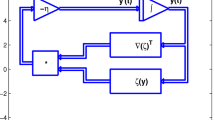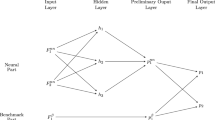Abstract
This paper presents a neural network model for solving two models for portfolio selection in which the securities are assumed to be uncertain variables. The main idea is to replace the portfolio selection models with linear programming (LP) problems. According to the convex optimization theory and some concepts of ordinary differential equations, a neural network model for solving LP problems is presented. The equilibrium point of the proposed model is proved to be equivalent to the optimal solution of the original problem. It is also shown that the proposed neural network model is stable in the sense of Lyapunov and it is globally convergent to an exact optimal solution of the portfolio selection problem with uncertain returns. Two illustrative examples are provided to show the feasibility and the efficiency of the proposed method in this paper.






Similar content being viewed by others
References
Abdelaziz FB, Aouni B, Fayedh RE (2007) Multi-objective stochastic programming for portfolio selection. Eur J Oper Res 177:1811–1823
Arenas-Parra M, Bilbao-Terol A, Rodríguez-Uría MV (2001) A fuzzy goal programming approach to portfolio selection. Eur J Oper Res 133:287–297
Bazaraa MS, Jarvis JJ, Sherali HD (1990) Linear Programming and Network Flows. Wiley, New York
Bian W, Chen X (2012) Smoothing neural network for constrained non- Lipschitz optimization with applications. IEEE Trans Neural Netw Learn Syst 23 (3):399–411
Bilbao-Terol A, Pérez-Gladish B, Arenas-Parra M, Rodríguez-Uría VRU (2006) Fuzzy compromise programming for portfolio selection. Appl Math Comput 173:251–264
Carlsson C, Fullér R, Majlender P (2002) A possibilistic approach to selecting portfolios with highest utility score. Fuzzy Sets Syst 131:13–21
Chen XW, Liu B (2010) Existence and uniqueness theorem for uncertain differential equations. Fuzzy Optim Decis Making 9:69–81
Cheng L, Hou Z , Tan M (2008) A neutral-type delayed projection neural network for solving nonlinear variational inequalities. IEEE Trans Circ Syst II: Exp Briefs 55 (8):806–810
Corazza M, Favaretto D (2007) On the existence of solutions to the quadratic mixed-integer meanvariance portfolio selection problem. Eur J Oper Res 176:1947–1960
De Cooman G (1997) Possibility theory IIII. Int J Gen Syst 25:291–371
Dubois D, Prade H (1988) Possibility theory: An approach to computerized processing of uncertainty. Plenum, New York
Effati S, Nazemi AR (2006) Neural network models and its application for solving linear and quadratic programming problems . Appl Math Comput 172:305–331
Facchinei F, Jiang H, Qi L (1999) A smoothing method for mathematical programs with equilibrium constraints. Math Program 85:107–134
Forti M, Nistri P, Quincampoix M (2004) Generalized neural network for nonsmooth nonliner programming problems. IEEE Trans Circ and Syst I Regular Pap 51 (9):1741–1754
Forti M, Nistri P, Quincampoix M (2006) Convergence of neural networks for programming problems via nonsmooth Lojasiewica inequality. IEEE Trans Neural Netw 17 (6):1487–1499
Friesz TL, Bernstein DH, Mehta NJ, Tobin RL, Ganjlizadeh S (1994) Day-to-day dynamic network disequilibria and idealized traveler information systems. Oper Res 42:1120–1136
Gao X (2009) Some properties of continuous uncertain measure. Int J Uncertain, Fuzziness Knowl-Based Syst 17:419–426
Gao X, Gao Y, Ralescu DA (2010) On Liu’s inference rule for uncertain systems. Int J Uncertain, Fuzziness Knowl-Based Syst 18:1–11
Gao X, Liao L, Qi L (2005) A novel neural network for variational inequalities with linear and nonlinear constraints. IEEE Trans Neural Netw 16 (6):1305–1317
Gupta P, Mehlawat MK, Saxena A (2008) Asset portfolio optimization using fuzzy mathe matical programming. Inf Sci 178:1734–1755
Hopfield JJ, Tank DW (1985) Neural computation of decisions in optimization problems. Biol Cybern 52:141–152
Hosseini A, Wang J, Mohamma S (2013) A recurrent neural network for solving a class of generalized convex optimization problems. Neural Netw 44:78–86
Hu X, Wang J (2006) Solving pseudomonotone variational inequalities and pseudoconvex optimization problems using the projection neural network. IEEE Trans Neural Netw 17 (6):1487–1499
Hu X, Wang J (2007) Design of general projection neural networks for solving monotone linear variational inequalities and linear and quadratic optimization problems. IEEE Trans Syst, Man and Cybern, Part B (Cybernetics) 37 (5):1414–1421
Huang X (2008a) Risk curve and fuzzy portfolio selection. Comput Math Appl 55:1102–1112
Huang X (2008b) Mean-semivariance models for fuzzy portfolio selection. J Comput Appl Math 217:1–8
Huang X (2008c) Portfolio selection with a new definition of risk. Eur J Oper Res 186:351–357
Huang X (2009) A review of credibilistic portfolio selection. Fuzzy Optim Decis Making 8:263–281
Huang X (2011) Mean-risk model for uncertain portfolio selection. Fuzzy Optim Decis Making 10:71–89
Huang X (2012a) Mean-variance models for portfolio selection subject to experts estimations. Expert Syst Appl 39:5887–5893
Huang X (2012b) A risk index model for portfolio selection with returns subject to experts’ estimations. Fuzzy Optim Decis Making 11:451–463
Ida M (2002) Mean-variance portfolio optimization model with uncertain coefficients. Proc IEEE Int Conf Fuzzy Sys 3:1223–1226
Inuiguchi M, Ramík J (2000) Possibilistic linear programming: A brief review of fuzzy mathematical programming and a comparison with stochastic programming in portfolio selection problem. Fuzzy Sets Syst 111:3–28
Kaufman A, Gupta MM (1985) Introduction to fuzzy arithmetic: Theory and applications. Van Nostrand Reinhold, New York
Kennedy MP, Chua LO (1988) Neural networks for nonlinear programming. IEEE Trans Circ Syst 35 (5):554–562
Klir GJ, Yuan B (1995) Fuzzy sets and fuzzy logic: Theory and applications. Prentice-Hall, New Jersey
Lacagnina V (2006) A stochastic soft constraints fuzzy model for a portfolio selection problem. Fuzzy Sets and Systems 157:1317–1327
León T, Liern V, Vercher E (2002) Viability of infeasible portfolio selection problems: A fuzzy approach. Eur J Oper Res 139:178–189
Lin CC, Liu YT (2008) Genetic algorithm for portfolio selection problems with minimum transaction lots. Eur J Oper Res 185:393–404
Liu B (2007) Uncertainty theory, 2nd ed. Springer, Berlin
Liu B (2009b) Theory and practice of uncertain programming, 2nd ed. Springer, Berlin
Liu B (2010) Uncertainty theory: a branch of mathematics for modeling human uncertainty. Springer, Berlin
Liu Q , Cao J, Chen G (2010) A novel recurrent neural network with finite-time convergence for linear programming. Neural Comput 22:2962–2978
Liu Q, Dang C, Huang T (2013) A one-layer recurrent neural network for real-time portfolio optimization with probability criterion. IEEE Trans Cybern 43 (1):14–23
Liu Q, Guo Z, Wang J (2012) A one-layer recurrent neural network for constrained pseudoconvex optimization and its application for portfolio optimization. Neural Netw 26 (1):99–109
Liu Q, Wang J. (2011) A one-layer recurrent neural network for constrained nonsmooth optimization. IEEE Trans Syst, Man Cybern, Part B (Cybernetics) 41 (5):1323–1333
Liu Q, Wang J (2013) A one-layer projection neural network for nonsmooth optimization subject to linear equalities and bound constraints. IEEE Trans Neural Netw Learn Syst 24 (5):812–824
Markowitz H (1952) Portfolio selection. J Financ 7:77–91
Markowitz H (1959) Portfolio selection: efficient diversification of investments. Wiley, New York
Miller RK, Michel AN (1982) Ordinary Differential Equations. Academic Press, New York
Nahmias S (1978) Fuzzy variables. Fuzzy Sets and Systems 1:97–110
Nazemi AR (2011) A dynamic system model for solving convex nonlinear optimization problems. Commun Nonlinear Sci Numer Simul 17 (4):1696–1705
Nazemi AR (2012) A dynamical model for solving degenerate quadratic minimax problems with constraints. J Comput Appl Math 236 (6):1282–1295
Nazemi AR (2014) A neural network model for solving convex quadratic programming problems with some applications. Eng Appl Artif Intell 32:54–62
Nazemi AR, Nazemi M (2014) A gradient-based neural network method for solving strictly convex quadratic programming problems. Cognitive Computation, (In press)
Nazemi AR (2013) A dynamic system model for solving convex nonlinear optimization problems. Commun Nonlinear Sci Numer Simul 17:1696–1705
Nazemi AR, Omidi F (2012) A capable neural network model for solving the maximum flow problem. J Comput Appl Math 236:3498–3513
Nazemi AR, Omidi F (2013) An efficient dynamic model for solving the shortest path problem. Transp Res C 26:1–19
Ortega TM, Rheinboldt WC (1970) Iterative solution of nonlinear equations in Several variables. Academic Press , New York
Peng ZX, Iwamura K (2010) A sufficient and necessary condition of uncertainty distribution. J Interdiscip Math 13:277–285
Quarteroni A, Sacco R, Saleri F (2007) Numerical mathematics. Springer-Verlag, Berlin
Tank DW, Hopfield JJ (1986) Simple neural optimization networks: An A/D converter, signal decision circuit, and a linear programming pircuit. IEEE Trans Circ Syst 33 (5):533–541
Tanaka H, Guo P (1999) Portfolio selection based on upper and lower exponential possibility distributions. Eur J Oper Res 114:115–126
Tanaka H, Guo P, Türksen B (2000) Portfolio selection based on fuzzy probabilities and possibility distributions. Fuzzy Sets Syst 111:387–397
Tiryaki F, Ahlatcioglu M (2005) Fuzzy stock selection using a new fuzzy ranking and weighting algorithm. Appl Math Comput 170:144–157
Vegas JM, Zufiria PJ (2004) Generalized neural networks for spectral analysis: dynamics and Liapunov functions. Neural Netw 17 (2):233–245
Vercher E, Bermúdez JD, Segura JV (2007) Fuzzy portfolio optimization under downside risk measures. Fuzzy Sets Syst 158:769–782
Wang J (1993) Analysis and design of a recurrent neural network for linear programming. IEEE Trans Circ Syst I: Fundam Theory Appl 40 (9):613–618
Watada J (1997) Fuzzy portfolio selection and its applications to decision making, vol 13. Tatra Mountains Mathematical Publication, pp 219–248
Xia Y (1996a) A new neural network for solving linear programming problems and its application. IEEE Trans Neural Netw 7 (2):525–529
Xia Y (1996b) A new neural network for solving linear and quadratic programming problems. IEEE Trans Neural Netw 7 (6):1544–1547
Xia Y, Wang J (1995) Neural network for solving linear programming problems with bounded variables. IEEE Trans Neural Netw 6 (2):515–519
Xia Y, Wang J (2004) A one-layer recurrent neural network for support vector machine learning. IEEE Trans Syst, Man Cybern, Part B (Cybernetics) 34 (2):1–10
You C (2009) Some convergence theorems of uncertain sequences. Math Comput Model 49:482–487
Zadeh L (1965) Fuzzy sets. Inf Control 8:338–353
Zadeh L (1978) Fuzzy sets as a basis for a theory of possibility. Fuzzy Sets Syst 1:3–28
Zhang WG, Nie ZK (2004) On admissible efficient portfolio selection problem. Appl Math Comput 159:357–371
Zhang WG, Wang YL, Chen ZP, Nie ZK (2007) Possibilistic mean-variance models and efficient frontiers for portfolio selection problem. Inf Sci 177:2787–2801
Zhu Y (2010) Uncertain optimal control with application to a portfolio selection model. Cybern Syst 41:535–547
Zimmermann HJ (1985) Fuzzy set theory and its applications. Kluwer Academic Publisher, Boston
Author information
Authors and Affiliations
Corresponding author
Rights and permissions
About this article
Cite this article
Nazemi, A., Abbasi, B. & Omidi, F. Solving portfolio selection models with uncertain returns using an artificial neural network scheme. Appl Intell 42, 609–621 (2015). https://doi.org/10.1007/s10489-014-0616-z
Published:
Issue Date:
DOI: https://doi.org/10.1007/s10489-014-0616-z




